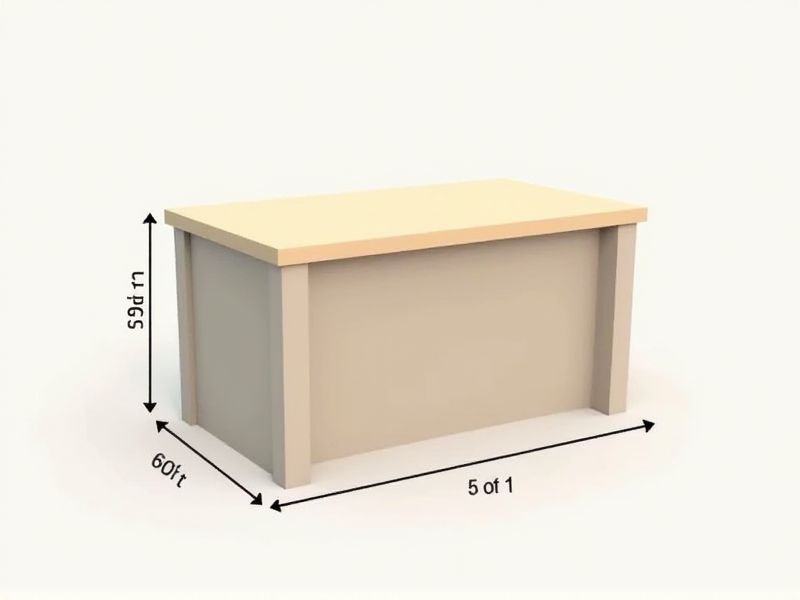
When planning your kitchen island, it's helpful to know the standard dimensions to ensure both functionality and comfort. Most kitchen islands are typically 36 to 48 inches long and 24 to 36 inches wide, providing ample workspace without overwhelming the area. The standard height is usually 36 inches, which matches most kitchen counters and is ideal for food preparation or casual dining. Make sure to allow at least 36 to 48 inches of clearance on all sides so there's enough space for people to move around and access appliances easily.
Width
A standard kitchen island typically measures between 36 to 48 inches in width, providing ample space for both functionality and aesthetics. This width allows for comfortable seating for up to four people when paired with appropriate stools, optimizing your kitchen for social interactions. For efficient workflow, consider a minimum clearance of 42 inches around the island to facilitate movement and access to appliances. When designing your kitchen, ensure that the width complements the overall layout, enhancing both usability and flow.
Length
The standard kitchen island length typically ranges from 4 to 8 feet, allowing for optimal workspace and seating accommodations. A length of 5 to 6 feet is often ideal for a family of four, providing ample room for meal preparation and socializing. If you prefer additional seating or incorporate features like a sink or cooktop, consider extending the length to 7 or 8 feet. Ensure your island is at least 24 inches deep to provide adequate counter space and improve functionality in your cooking area.
Height
The standard height for a kitchen island typically ranges from 36 to 42 inches, making it ideally suited for both cooking and dining purposes. This height allows for comfortable meal prep while also accommodating bar stools for casual seating. When designing your kitchen island, consider ergonomic principles to ensure ease of use, especially for taller individuals who may benefit from a slightly increased height. Additionally, incorporating varying levels, such as a raised counter for bar seating, can enhance functionality and aesthetic appeal.
Overhang
The overhang of a kitchen island typically ranges from 12 to 24 inches, providing ample space for seating and meal preparation. This overhang allows for comfortable legroom, accommodating stools or chairs for family and guests. Ideally, a kitchen island should have a height of 36 to 42 inches, ensuring it fits seamlessly within the overall kitchen design. When incorporating an overhang, it's essential to consider supporting brackets or cabinetry to maintain structural integrity, especially for larger spans.
Clearance Space
For an efficient kitchen island design, maintaining at least 36 inches of clearance space around the island is essential for comfortable movement. This space facilitates easy access to appliances, cabinetry, and allows multiple users to navigate without hindrance. If your kitchen is more compact, aim for a minimum of 24 inches of clearance, though this may compromise usability. Ensuring these clearance dimensions not only enhances functionality but also promotes a safer kitchen environment.
Seating Space
A standard kitchen island typically includes seating space for 3 to 4 individuals, providing a casual dining experience. The optimal height for seating is generally 36 inches, allowing for comfortable use of bar stools or counter-height chairs. You can enhance the functionality of your kitchen island by incorporating an overhang of at least 12 inches to accommodate legroom. This design not only fosters social interaction but also maximizes the usability of your kitchen area.
Storage Options
A well-designed kitchen island typically incorporates efficient storage solutions, such as cabinets and drawers, to maximize functionality. Ideally, a kitchen island should have at least 20 to 30 cubic feet of storage space to effectively accommodate pots, pans, and utensils. Consider integrating open shelving or wine racks, allowing you to easily access frequently used items while showcasing your favorite dishes. You can enhance organization by including pull-out shelves, which can hold heavier items and keep your kitchen clutter-free.
Work Triangle
The kitchen island is ideally designed to enhance the work triangle, which consists of the three main work zones: the stove, sink, and refrigerator, typically within a distance of 4 to 9 feet from each other. A well-planned kitchen island provides a minimum surface area of 30 inches for food preparation while maintaining a clearance of 42 inches around it to ensure easy movement. Incorporating storage solutions like cabinets or pull-out drawers into the island can improve efficiency and organization, especially in kitchens with limited space. This focus on the work triangle not only maximizes functionality but also elevates the overall cooking experience.
Material Choice
Selecting the right material for your kitchen island is crucial, as it significantly affects aesthetics, durability, and maintenance. Popular choices include granite, quartz, and wood; granite offers resilience and variety with patterns, while quartz provides a non-porous surface that resists stains and scratches. If you prefer a warmer touch, hardwood adds natural beauty, although it requires regular sealing to prevent damage. Your choice should align with your cooking habits, style preferences, and the overall design of your kitchen.
Electrical Outlets
A well-designed kitchen island should include a minimum of two electrical outlets to accommodate various appliances, such as blenders and toasters. Ideally, these outlets should be strategically placed on the sides for easy access, allowing you to maximize your workspace without compromising aesthetics. For safety, choose outlets rated for at least 15 amps, ensuring they can handle multiple devices without tripping. Including USB ports in your kitchen island outlets can streamline charging for your devices, making your kitchen both functional and modern.
